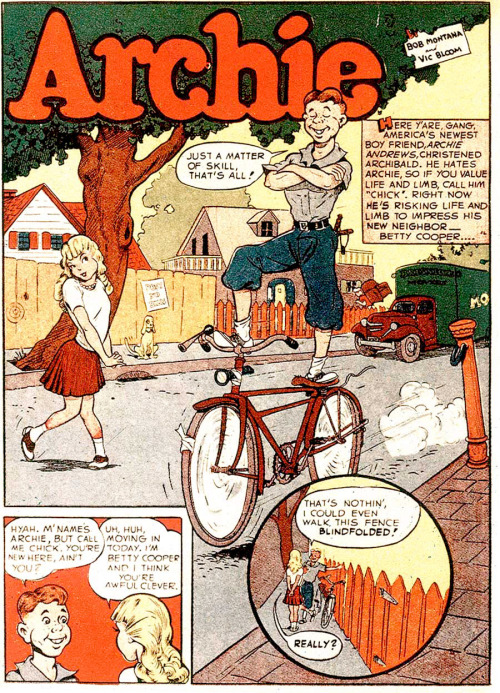Archie meets Betty for the first time in the very first Archie story in PEP #22. It’s in
Archie meets Betty for the first time in the very first Archie story in PEP #22. It’s interesting to remember the original context Archie was published in. The reason Archie’s life seems so bucolic and Little Rascals-esque is that, really, the idea of a teen-ager (an in-between state, between being a child and adult) is something of a post-1945 idea. You were either a kid or adult. Prior to that, children were considered adults very early on in life, and were also expected to work for the family and take large responsibilities. There was also no culture unique to them as of yet, which is why what we would call “teenagers” in movies prior to the 1950s listened to the same music and dressed the same as their parents did. This is also why, in that cultural context, superhero “kid sidekicks” were not considered as strange as they later would look (e.g. unconscionable child endangerment). In other words, Archie Comics mostly predate the cultural idea of a teenager. Of all the major, valuable comics from the Golden Age, PEP #22 (December 1941) is the rarest as only 22 issues are believed to still be in existence. A new one has not been discovered in some time, so for that reason, it’s hard to give a real price on what one would be worth, since it doesn’t change hands too often. One of the most startling things about the golden age is that comics sold in the millions, but they were so disposable, there are issues that no longer survive today, or issues that only have a single existing copy. It’s interesting to have a look at the cover of the first Archie comic. Interestingly, as 1941 was right in the middle of the wartime fad of patriotic superheroes, the debut of Archie did not take the cover of the comic at all, but was buried in the backup and wasn’t even mentioned on the cover, which had the Shield Interestingly, the Shield looks like a Captain America copy or rip off, but surprisingly…the Shield came first. Captain America’s shield, originally a medieval one, was changed to a round disk by the second issue, as it evoked the design of Archie’s Shield too much. If you’ve ever read comics from the 1940s, you know that they usually had five or six stories, not all of the same genre. There was the superhero story that got the cover, but also usually a detective, or magician in tophat and tails, an aviation action strip, and usually, somewhere in the back, a strip about a friendly skunk or other cartoon animal in white gloves, and last of all, almost as forgotten as the advertisements, there was the strip about the funny kid, like Sugar n’ Spike or “Lil’ Sis.” Later on in the decade, when Yankee GIs and soldiers started reading comics as well as kids, another standard strip in a 1940s comic would usually also be a hot girl story (like Bill Ward’s Torchy, Canteen Kate, or Katy Keene) which are essentially about a gorgeous fantasy woman who, in 8 pages, encounters an extremely mild and easily resolved life problem while standing around in pin up poses, and usually showers in the middle of the story or takes a bath. Considering the audience for this was soldiers overseas, we’ve only recently started to acquire the language to describe the appeal of the good girl comic: parasocial.I cannot emphasize enough how surprising it is that, in that context, the “funny kid” comic in Archie not only dominated the book, but changed the name of the company, to the point that nobody even remembers that Archie Comics published superheroes or detective/aviation comics. Most comics had a “funny kid,” but nobody, not even fans, keep track of them. I once tried looking up if there was a master list of funny kid comic backups of the 40s and 50s, and I couldn’t find it, just…nobody takes an interest in this, even in the comics and collector world. The one other great unlikely survival of a funny kid comic from the 50s to the present was Sugar and Spike, who got their own comic that was published for decades. As a collector, I always get whiplash whenever I see a Sugar n’ Spike comic from the 1970s. Like Katy Keene, they were a coelocanth-like survivor of the mass extinction of kid comics and hot girl comics. -- source link
Tumblr Blog : vintagegeekculture.tumblr.com
#archie

